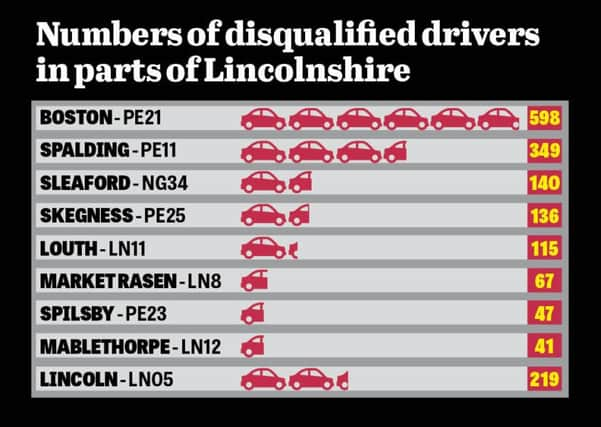DRIVER DISQUALIFICATION FEATURE: Banned! Number of drivers taken off our roads for drink and drugs


Last week motoring.co.uk released the information in a bid to promote driver safety during the Euro 2016 football tournament.
However, the figures have been interpreted by some experts to highlight potential issues in towns with a high number of migrant communities. Here we take a closer look at the figures across Lincolnshire.
Advertisement
Hide AdAdvertisement
Hide AdTowns with the highest and lowest number of motorists banned due to drink-driving or being unfit through drugs have been revealed - with Boston shamed as the worst in the county at 598, while Mablethorpe has the least with 41. In fact, Boston comes out second nationally - with only only Croydon in London having more - 687.
The figures were released by Motoring.co.uk in a bid to promote road safety - particularly during the Euro 2016 tournament.
Following the release of the figures, which do not include the offenders’ nationalities, it was suggested that high levels could be linked to migrants not understanding British drink-driving laws.
AA President Edmund King told the paper: “Looking at the facts of the country as a whole, nationally it does seem to be more drink-driving convictions in areas where we have more migrant workers.”
Advertisement
Hide AdAdvertisement
Hide AdHe added the number of breathalyser tests carried out by the forces in general could have an effect on the results within the FOI - which looked at the period January 2011 to December 2015.
“The more breathalyser tests the more likely it is the force will have positive results,” he said.
Mr King said the introduction of breathalysers had been a big factor in the reduction of drink-drivers but said that without knowing how many tests each force carried out it was difficult to say how each force was actually doing. He pointed to a campaign against drink-driving in the UK over a number of decades, particularly during Christmas and summer times and said the message about drink-driving in the UK had generally been good.
He added: “One of the general points is if you have got a large number of overseas workers that haven’t picked up on the years of campaigning.”
Advertisement
Hide AdAdvertisement
Hide AdHe said the 12 month suspension minimum that drivers can get for committing the offence was a deterrent.
John Siddle, from the Lincolnshire Road Safety Partnership, however, said migrants could not necessarily claim ignorance of the UK’s laws.
He said there had been a compaign in 2012-13 which took steps to tackle the issues in the migrant communities, including posters in various languages and going out and speaking to people and businesses.
He said: “At the time it was really difficult to dig down into the data. We couldn’t just go on arrest records because the people may have foreign sounding names but could have been third generation families.”
Advertisement
Hide AdAdvertisement
Hide AdHe explained they had to look at things like National Insurance numbers and driving licenses and ‘all sorts of bits and pieces’ to put the data together and create an accurate picture.
He said: “The way it came out, it was quite shocking that they [Eastern European migrants] represented something around six per cent of the population of Lincolnshire, but 32 per cent of the drink-drive arrests.”
He told how the partnership and other organisations then worked to educate migrants and make them aware of what the law is.
He said: “I think, on the back of that campaign, whilst there’s some argument that the migrants from then, some of those have gone home and more have come over to replace them and migration is on the increase, we still think that the message is out there.”
Advertisement
Hide AdAdvertisement
Hide AdHe said it was ‘very, very rare’ for foreign nationals caught drink-driving to turn around and say they didn’t know. He also pointed to the drink-drive law in Poland being limited to 0 microgrammes of alchohol in a person, compared to the UK’s limit of 35 for breath, 80 for blood and 107 in urine.
He did, however, say that there had been a focus in safety campaigns to do with drink-driving across the UK over the past 50 years, which had created a culture where residents in the country found it socially unacceptable to drink-drive, adding though that there were still English people who do it. He said the culture may not apply to foreign nationals since they had not had the same sustained campaigning ‘thrust upon them’.
Motoring.co.uk managing director Terry Hogan said: “The latest figures showing the drink-driving hot-spots around Lincolnshire area are a concern for all those interested in road safety, from drivers to other road users, to local authorities and law enforcement.
“We urge all drivers to remember and to respect the rules when it comes to driving and alcohol, particularly during the upcoming summer months which see increased celebrations and social activity.”